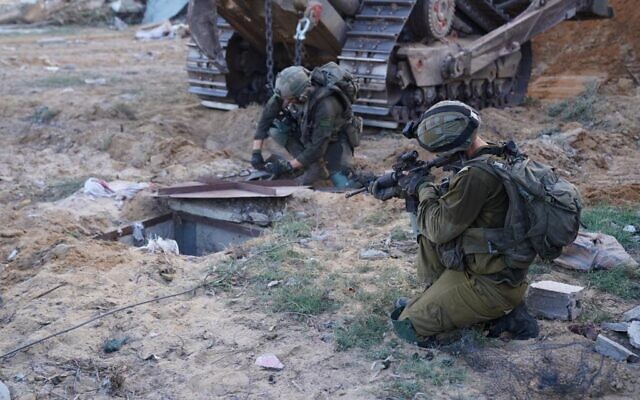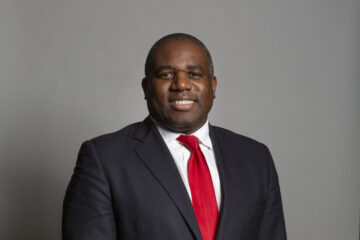
Soldiers guard the entrance to a Hamas tunnel in the Gaza Strip, in a handout photo published November 9, 2023. (Israel Defense Forces), via Times of Israel.
Latest developments
- A month on from Hamas’s October 7 mass terror attack, Israeli ground forces are advancing deeper into Gaza city, and closing in on Hamas’s main command centre, located underneath the Al Shifa Hospital.
- The IDF continues to target Hamas’s underground tunnel network and military infrastructure, and have released footage shot by troops showing rocket launchers in civilian buildings including a youth centre and a mosque. Overnight airstrikes and operations reportedly killed more Hamas field commanders.
- On 7 November, Israelis marked one month since the Hamas terror attacks with vigils across the country. The victims include 1,454 killed, 245 confirmed abducted, including children as young as 9 months, and dozens of Israelis still unaccounted for. Armed groups continue to fire rockets from Gaza into Israel daily. Around 9,000 rockets have been fired in total, with the IDF estimating 10% falling in the Gaza Strip or in the sea. Hundreds of thousands of Israelis have been displaced from communities close to the Gaza and Lebanese borders.
- As Israeli forces enter deeper into Gaza City, the flow of Palestinian civilians south out Gaza City has increased, taking advantage of a daily evacuation window announced by the IDF corridor on the Salah a-Din road. On 7 November (according to UN estimates) around 15,000 Gazan civilians moved southward. The IDF has accused Hamas of firing on troops securing the corridor and preventing people from leaving.
- The Hamas run Gaza Health Ministry claims (as of 9 November) 10,582 Palestinians killed, of whom two thirds are women and children. There is no way to independently verify the numbers, what percentage are combatants, and how many were harmed by misfiring Palestinian rockets, such as the one that struck the Al Ahli Hospital on 17 October. As of 7 November, Israel had lost 30 soldiers killed inside the Gaza Strip.
- Iranian-backed Hezbollah and Palestinian armed groups in south Lebanon continue to fire dozens of rockets daily at Israeli communities in northern Israel, and anti-tank missiles that have killed six Israeli soldiers and two civilians, including a 55-year-old man on 7 November. Israel continues to hit Hezbollah targets in response.
- In a speech on 3 November, his first since the outbreak of war, Hezbollah leader Hassan Nasrallah indicated his continued support to Hamas whilst avoiding any commitment to escalate Hezbollah’s involvement further. Iranian-backed Houthi rebels in Yemen have fired periodically at southern Israel including a drone they claimed to have sent on 6 November.
- There is ongoing violence in the West Bank including IDF raids to arrest wanted Palestinians leading gun battles and fatalities, and a series of reported terror attacks by Palestinians on Israeli soldiers and civilians. There has also been an alarming uptick in attacks by Israeli settlers against Palestinians in the West Bank, which have been condemned by Israeli prime minister Benjamin Netanyahu and the White House.
- International diplomacy continues to focus on humanitarian pauses, possibly linked to the release of hostages. In an interview on 6 November, Benjamin Netanyahu declared that there would be “no general ceasefire without the release of our hostages”. He added that humanitarian pauses were dependent on “check[ing] the circumstances in order to enable goods, humanitarian goods to come in, or our hostages, individual hostages to leave”.
- G7 foreign ministers issued a joint statement on 8 November affirming “Israel’s right to defend itself and its people in accordance with international law as it seeks to prevent a recurrence” of the Hamas attacks. The statement called for “humanitarian pauses and corridors to facilitate urgently needed assistance, civilian movement, and the release of hostages,” whilst calling on Iran “to refrain from providing support for Hamas and taking further actions that destabilize the Middle East.”
- This came following a tour of Middle East capitals by US secretary of state Anthony Blinken, at the conclusion of which he said the Biden administration was pushing “very aggressively” to dramatically expand aid reaching civilians in Gaza.
- International humanitarian aid efforts to help Gazan civilians are expanding. On 6 November, Jordan’s air force air-dropped medical supplies in a move coordinated with Israel and the US, while the United Arab Emirates has sent equipment for a field hospital.
- Since Israel’s agreement to the entry of 100 aid trucks a day, truckloads entering via the Rafah crossing with Egypt have varied daily, with 98 on 6 November and 81 on 7 November, primarily carrying food, medicines, health supplies, bottled water and hygiene products. 436 trucks have entered Gaza in the past week.
- More than 1.5 million Gazans are internally displaced, with acute shortages and overcrowding in shelters. Several hundred foreigners and dual nationals can cross the border to Egypt each day, and a small number of seriously injured.
What follows Hamas rule after the conflict?
- Focus is increasing on who can replace Hamas in governing the Gaza Strip. US Secretary of State Antony Blinken had said that the Biden administration’s view that a “revitalised” Palestinian Authority should resume control of Gaza once Israel has succeeded in toppling Hamas, with regional partners and international agencies playing a transitional role.
- When asked on ABC News on 6 November who could govern Gaza after the war Netanyahu said “those who don’t want to continue the way of Hamas”, adding that Israel would retain “overall security responsibility”.
- Speaking to Israeli communities in Southern Israel on 6 November, National Unity party leader Benny Gantz, who joined the government to serve in an emergency war cabinet, stressed that “We’re not going to wipe out Gaza … But there won’t be a security threat that will endanger you.”
- According to a Haaretz report on Israeli opposition leader Yair Lapid told US senators last week “the only solution after Hamas is removed … is to bring back the Palestinian Authority backed by international forces.”, whilst Labour leader Merav Michaeli has said, “We must work hand in hand with the United States, Europe, Egypt, Jordan, Saudi Arabia and the Palestinian Authority to formulate a framework that will allow Israel to leave Gaza when Gaza is demilitarized and where Hamas will not be able to re-establish itself.”
Israeli domestic politics
- There have been increasing calls from within Israel for Netanyahu to resign immediately or as soon as the war is concluded, including within the pro-Netanyahu Yisrael Hayomnewspaper, and there have been renewed protests outside Netanyahu’s home. This comes after a period in which anti-government protestors had refrained from calling for a change of leadership during the war.
- Mansour Abbas, leader of the Arab-majority Ra’am party, which participated in the previous Israeli government, has spoken out again against the Hamas attack in a radio interview, saying, “The massacre is against everything we believe in, our religion, our Islam, our nationality, our humanity,” and declaring that Hamas’ actions do “not represent our Arab society, nor our Palestinian people nor our Palestinian nation.”
In the UK
- A pro-Palestinian march on Saturday from Marble Arch to the US embassy will go ahead despite concerns it may disrupt Armistice Day commemorations.
- Some 29 people were arrested following pro-Palestine demonstrations in central London on the weekend of 4/5 November, with reports of protestors carrying a sign depicting a bulldozer flying the Palestinian flag – a reference to the 7 October attacks – alongside genocidal chants of “from the river to the sea”, and at least one instance of a man being arrested for antisemitic comments.
- From 7 October to 7 November, CST recorded at least 1124 antisemitic incidents across the UK, the highest ever totals reported to CST. Many involved verbal abuse, but the total also includes 55 assaults and 75 examples of damage and desecration of Jewish property.
- The King’s speech included a commitment “to tackling antisemitism and ensuring that the Holocaust is never forgotten” with proposals for “A bill will progress the construction of a national Holocaust Memorial and Learning Centre in Victoria Tower Gardens.” It also referred to the government’s commitment to address challenged including “the consequences of the barbaric acts of terrorism against the people of Israel, facilitating humanitarian support into Gaza and supporting the cause of peace and stability in the Middle East.”
- In his response, Keir Starmer recalled the “senseless murder of Jews by the terrorists of Hamas and the taking of hostages on 7 October,” and reiterated, “We need a humanitarian pause now and for the hostages to be released now. Israel has the right and duty to defend herself, but that is not a blank cheque; it must comply with international law.”
The coming days
- Israel’s steady advance into the heart of Gaza City and towards Al Shifa Hospital will continue. It may be that the IDF is yet to meet the fiercest Hamas fighting on the ground, with Hamas fighters prepared to stay underground for a long period.
- The IDF has reportedly discovered Hamas’s tunnel networks to be of unprecedented sophistication and needs more time to sweep the northern Gaza Strip and destroy Hamas’s infrastructure. There may be increasing pressure from the US for Israel to move on from this phase of its campaign, withdraw the bulk of its forces, and shift to a phase of more pinpointed operations.
- Diplomatic efforts will continue to focus on the possibility of creating humanitarian pauses in return for or to allow for the release of hostages.
- The risk of the conflict escalating on the Northern front with Hezbollah and its extensive military capabilities remains ever present.

